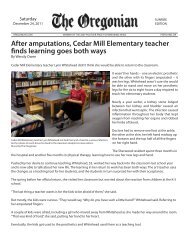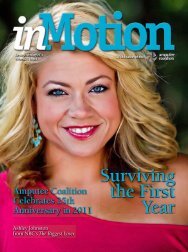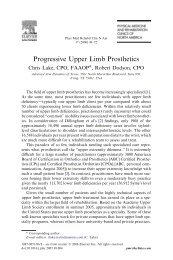Planning for Prosthetics - Advanced Arm Dynamics
Planning for Prosthetics - Advanced Arm Dynamics
Planning for Prosthetics - Advanced Arm Dynamics
Create successful ePaper yourself
Turn your PDF publications into a flip-book with our unique Google optimized e-Paper software.
PROSTHETIC REHABILITATION LEADS TO AN ACTIVE LIFE<br />
Upper limb loss secondary to traumatic injury is often the result of on-the-job accidents. Shawn Findley was working on a punch<br />
press in an industrial fabrication shop when a portion of his hand was amputated by a machine. In an attempt to save what remained<br />
of his injured hand, Findley endured 13 surgical procedures, only to still be faced with persistent pain and a partial hand that offered<br />
minimal function. He consulted with an upper limb prosthetist and occupational therapist to learn about the prosthetic options that<br />
would be available if he decided to have the injured hand amputated.<br />
Three years after his injury, Findley decided to have his hand amputated. This was the pivotal point in his return to a productive<br />
and fulfilling lifestyle. Once this decision was made, his surgeon, prosthetist and OT collaborated with him to discuss his functional<br />
goals and how he saw himself using a prosthesis. He determined that he would benefit from a myoelectric prosthesis with a custom<br />
cosmetic covering <strong>for</strong> many of his activities of daily living. He also chose an activity specific device to enable him to participate in<br />
coaching soccer, baseball and basketball <strong>for</strong> his children again.<br />
It is ideal to engage in this collaborative process prior to amputation and provide in<strong>for</strong>mation to the surgeon to determine the<br />
optimal level of amputation <strong>for</strong> successful prosthesis use. Preserving length is not always the surgeon’s guide. Other important<br />
considerations include allowing room <strong>for</strong> use of prosthetic components and the patient’s ability to activate <strong>for</strong>earm muscles <strong>for</strong><br />
myoelectric control.<br />
Findley’s OT tested and identified adequate myoelectric muscle sites (wrist extensors and flexors) and began training the muscles<br />
<strong>for</strong> use. After an extended period of inactivity, Findley’s muscles had atrophied considerably. Training muscle facilitation be<strong>for</strong>e and<br />
after amputation strengthened these muscles <strong>for</strong> independent control of opening and closing a terminal device once he was fit<br />
with his first prosthesis.<br />
After amputation and preparatory prosthesis training, Findley was pain-free and began to gain more independence in self-care and<br />
higher level bi-manual tasks.<br />
GENERAL REHABILITATION FRAMEWORK<br />
The upper limb prosthetic rehabilitation process is organized into broad segments that help give focus and continuity to the longterm<br />
treatment plan. These segments are not finite and may overlap. Smurr et al characterize these stages as follows:










